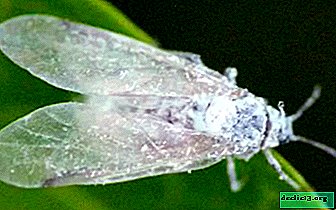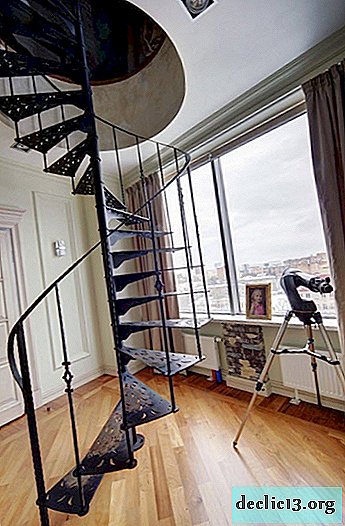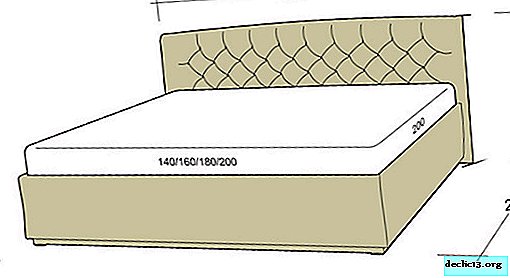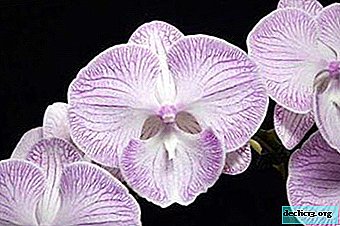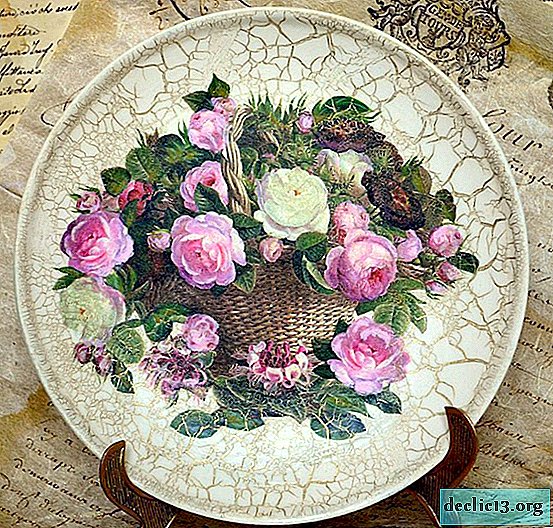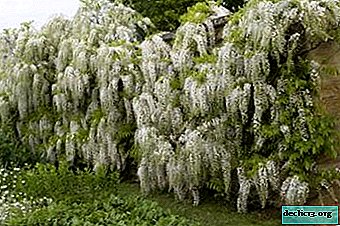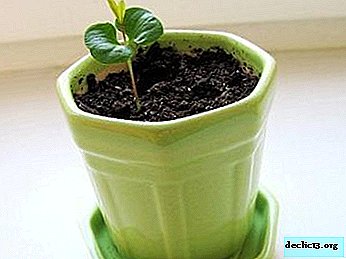Beautiful smithianta: description and photo of species. Nuances of plant care

Smitianta attracts attention with its delicate velvet leaves and unusual flowers - bells of amazing colors.
Fans of this plant collect entire collections that delight the eyes of their owners with long flowering. Next, we will tell what kind of plant it is, we will consider in detail all types. Learn how to propagate a flower, the nuances of care. What is the difficulty of growing in open ground. And also what diseases and pests should be feared.
Botanical Description
Smitianta belongs to the genus of perennial rhizome plants, is part of the Gesneriaceae family. The homeland of the plant is considered the mountainous regions of Central and South America.
Smitianta is a perennial plant with soft, pubescent stems. Opposite long-leaved leaves are heart-shaped and covered with a layer of villi. The leaves are located along the entire length of the stem, reaching a height of one meter.
On a note. In the spring, apical inflorescences bloom. They consist of 10-20 tubular or tubular bell-shaped drooping flowers of various colors.Description and photo of species
There are nine species of this plant. Further, the most famous varieties among flower growers.
Cinnabar Red (Smithiantha cinnibarina)
A plant with long (about 15 cm) velvety leaves in a dark green color. This species is small in size, the plant does not exceed 30 cm in height. The inflorescence is about 25 cm high and consists of red-orange drooping bells with a yellow center. The smithianta is vermilion red from spring to autumn. After flowering, a dormant period begins.

Multiflora (Smithiantha multiflora)
Herbaceous perennial up to 30 cm high. The leaves are round-heart-shaped with short teeth on the edges, have a lighter color than other types of smithyant. The flowers are white or creamy white, up to 4 cm long. The multicolor smythianta is often used by breeders to hybridize and breed new varieties.

Punctate (Smithiantha punctata)
Decorative perennial 30-40 cm high. The leaves are rounded, 16-18 cm long and have a pattern of purple veins. The flowers look like long tubes, expanding towards the edge. The pharynx of the flower is bright yellow and covered with dark red dots.
Striped (Smithiantha zebrina)
The plant is erect, up to 60 cm high. The leaves are heart-shaped, up to 15 cm long, dark green in color. Along the purplish-brown veins, spots of the same color are located. It blooms in summer and autumn. The size of the flowers is 3 - 4 cm, the pharynx of a flower with a spotty pattern.

Shiny (Smithiantha fulgida)
Reference! Rarely seen in gardeners. You can see it in the collections of true connoisseurs of this plant.The leaves are rounded, serrated closer to the edge, covered with a short pile. The flowers are red-orange. The lower part is lighter with a dotted pattern.

Adorable (Smithiantha amabilis)
Herbaceous perennial, upright stalk, about 40 cm high. Leaves are rounded, slightly pubescent. Apical inflorescences 25-30 cm high. Bell-and-tubular flowers 3.5 to 4 cm long. Flowering continues from spring to autumn.

Breeding
The smithiant is propagated in three ways:
- seeds;
- cuttings;
- division of the rhizome.
Seeds
Important! There is a lot of planting material, but the labor involved in obtaining it is significant.Recommendations for proper planting and seed germination:
- Smitiants recommend seed propagation from January to March.
- To minimize the likelihood of a disease of tender shoots of smithianta, it is recommended that soil and containers be treated before planting. Scald the container with boiling water, and the earth is treated with a weak solution of potassium permanganate. Then pour the soil into the prepared container, lightly tamp and moisten.
- The seeds of smithianti are very small, when planted they are not buried in the ground, but they are surface-sown.
- Germination of seeds occurs in the light and for a container with planted seeds, they prepare a suitable place near the window, but out of reach for direct sunlight.
- For seed germination, the soil should remain slightly moist and, after sowing, the container should be covered with a film, put in a greenhouse or under glass.
- The temperature in the room should not exceed 25 ° C.
- After 2 to 3 weeks, seedlings appear, and after a month, when several real leaves appear on the plants, the seedlings should be dived. After another month, seedlings can be planted in separate pots.
After six months, expect the first flowering.
Cuttings
 Propagation by cuttings is carried out during the entire active period of the growing season. The leaves of smithiantes are cut 5-7 cm long and rooted in water, and after the formation of roots, they are planted in containers filled with wet peat mixture or primer soil.
Propagation by cuttings is carried out during the entire active period of the growing season. The leaves of smithiantes are cut 5-7 cm long and rooted in water, and after the formation of roots, they are planted in containers filled with wet peat mixture or primer soil.
Within two weeks for plants provide a temperature of at least 25 ° C and high humidity. To do this, place seedlings in a greenhouse or under a film. Over time, the cuttings will grow stronger, but, with the end of the growing season, the aboveground part of the plant will die, and in the spring new shoots will go from the root.
Division
The propagation of smithiant by making rhizomes is desirable to combine with plant transplantationwhich is carried out after the end of the rest period. The plant is carefully removed from the pot and freed from the ground, and then the scaly rhizome is cut with a knife into 2-3 parts and planted in different pots. The earth is kept a little moist. Watering can be increased after the appearance of new leaves.
Home Care
Many consider the smithiant a rather whimsical plant, requiring a lot of attention and time when growing at home. But in fact, if everything is properly organized at once, then this wonderful flower will not cause serious trouble.
- Lighting. Smitianta prefers well-lit places, but the light should be scattered, without direct sunlight on the delicate leaves of the plant. Great windows facing east or west.
Recommendation. It is good to place the smithiant in the depths of the southern room. On the northern windowsill, the lighting is not enough for the flowering Smithyant.
Avoid direct sunlight. This leads to leaf burns.
- Watering. During the period of active vegetation, the smytiant needs abundant watering. But the plant should not be transfused - waterlogging, like drying out, an earthen coma is bad for the state of the rhizome. They recommend watering the smithiantes in a pan. During dormancy, the plant is watered rarely and not abundantly. Enough 1 time in 2-3 weeks.
- Temperature mode. Smitianta prefers moderate heat during the period of active growth. She is comfortable at + 22 ... +25 ° C. In winter, a slight decrease in temperature is permissible, but not lower than +20 ° C.
- Condition and quality of soil. It is preferable to plant the smithiant in peaty soil, which is well permeable to moisture and air, or in a prepared mixture for senpolia. Make up a mixture of soil and independently from the sheet and turf soil, coniferous soil and peat. It is important to maintain moderate soil moisture, avoiding overfilling and drying out.
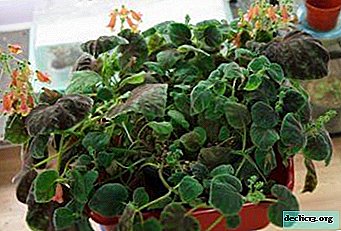 The choice of containers for growing. Smitianta has a superficial root system and the container for its growth should be chosen not very deep, but wide enough, where the diameter is about 15 cm. Drainage must be laid on the bottom.
The choice of containers for growing. Smitianta has a superficial root system and the container for its growth should be chosen not very deep, but wide enough, where the diameter is about 15 cm. Drainage must be laid on the bottom.- Feeding. In the spring and summer, the smythiant needs additional nutrition. It is good to use fertilizers for violets or for flowering plants. The main condition is a large amount of potassium in the composition. Top dressing smithiant spend 2 times a month.
- Trimming (pinching). To maintain the compact shape of the smithiant, pinching its tops is regularly carried out. This stimulates the growth of new lateral shoots and peduncles.
Features of outdoor care
Smithianta is grown not only at home, but also in the warm season, planted on flower beds, in boxes and hanging flower pots.
Important! It should be remembered that the smythiant does not tolerate direct sunlight and the place for planting should be slightly shaded, and heavy rainfall can damage the decorativeness of fleecy leaves.If the smithiant was planted in a hanging pot, then you should be careful about watering and dressing the plant.
Diseases and Pests
Among pests, Smithyans include insects such as whiteflies, aphids, thrips, or ticks. If you find them during the inspection of the plant - urgently conduct treatment with insecticides. Of the fungal diseases, the smythiant is affected by oidium and gray rot. Treatment with fungicidal agents will solve this problem.
Of the difficulties encountered during cultivation, there are three main ones:
- Plaque on the leaves. It occurs due to waterlogged soil and insufficient ventilation in the room.
- No flowers appear. The reason is the lack of light and minerals.
- There are brown spots on the foliage. Appear when exposed to direct sunlight, irrigation with cold water, or wet wet hairs Smithyanthus.
Smitianta is an amazing plant that is not so common in our homes. But true connoisseurs of graceful beauty have long appreciated and loved her. With the right approach, the smithiana will delight its owners with long and plentiful flowering.

 The choice of containers for growing. Smitianta has a superficial root system and the container for its growth should be chosen not very deep, but wide enough, where the diameter is about 15 cm. Drainage must be laid on the bottom.
The choice of containers for growing. Smitianta has a superficial root system and the container for its growth should be chosen not very deep, but wide enough, where the diameter is about 15 cm. Drainage must be laid on the bottom.

